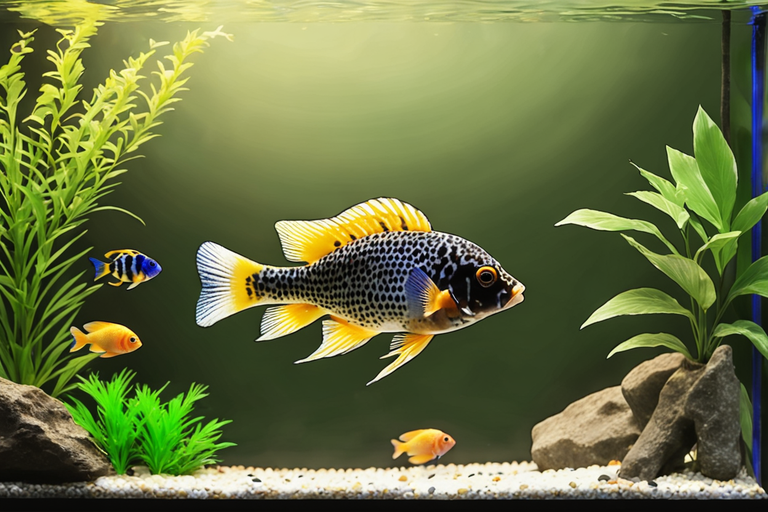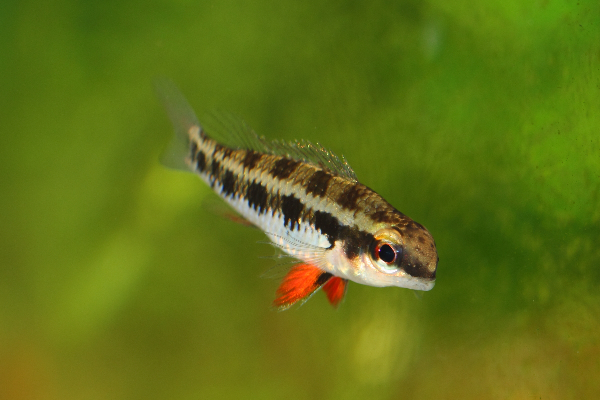Are you looking to add a unique and beautiful fish to your aquarium? The checkerboard cichlid may be the perfect choice for you! This fish is known for its vibrant colors and its peaceful nature, making it a great choice for any aquarium.
In this guide, we’ll cover everything you need to know about checkerboard cichlid care, including tank mates, diet and feeding, and breeding.
So, let’s get started!
Overview and Quick facts
Gaining an understanding of the checkerboard cichlid’s needs and characteristics is key to providing them with the best care possible. Checkerboard cichlids are a type of freshwater fish from the cichlidae family, which originates from the African rift lakes. They’re popular for their vibrant coloration, distinctive checkerboard pattern, and active personalities. When taken care of properly, checkerboard cichlids typically live between 5-7 years and can reach a size of 3-4 inches.
The ideal tank size for checkerboard cichlids is 20 gallons, and should have a pH level of 7.2-8.5. As they’re active swimmers, they require plenty of open swimming space, so tanks should be decorated with rocks and plants that don’t obstruct the swimming area. Checkerboard cichlids are also known for their territorial behavior, so it’s best to keep them in a longer tank rather than a tall one. When housing multiple checkerboard cichlids together, it’s recommended to introduce them slowly to help them establish a hierarchy.
Checkerboard cichlids require a well-balanced diet of both plant matter and protein. A quality cichlid pellet, along with occasional feedings of live or frozen foods such as bloodworms or brine shrimp, will help provide them with all the necessary nutrients. As they’re naturally foragers, checkerboard cichlids can also benefit from the addition of sinking pellets or catfish wafers to the tank, and vegetables like cucumber, zucchini, or spinach can also be offered.
Checkerboard cichlids can be a rewarding addition to any freshwater aquarium, provided they’re given the correct environment and diet. With proper care, you can enjoy watching these vibrant fish as they swim around their tank and explore their surroundings.

Appearance & Behavior
By understanding their appearance and behavior, you can better care for your checkerboard cichlids. These fish are easy to recognize due to their distinct black and white pattern. They have a robust body with two dorsal fins and a pointed head. Checkerboard cichlids have a life span of around 3-5 years and reach an adult size of up to five inches.
Here are some key points to remember when caring for these fish:
- Socializing:
- Checkerboard cichlids are social fish and should be kept in small groups of 3-5.
- Make sure to introduce new fish gradually, as they may become territorial.
- These fish can be kept with other peaceful species, like small tetras.
- Tank Design:
- Provide plenty of hiding places and cover to prevent bullying and stress.
- Aim for a tank size of at least 30 gallons.
- Decorate with plenty of rocks, driftwood, and live plants.
Checkerboard cichlids are hardy and relatively easy to care for. With the right attention and maintenance, these fish can be a rewarding addition to any home aquarium.

Care and Tank Requirements
Having the right tank setup and proper care for your checkerboard cichlids is essential for their health and happiness. This species of cichlid requires a tank size of at least 55 gallons, and it should be well-filtered and heated to the right temperature range of 75-80°F. To maintain good water quality, regular water changes and tank maintenance should be done, and the water parameters should be tested regularly to ensure they’re within the optimal range.
Checkerboard cichlids are omnivores, and their diet should consist of both plant matter and protein-rich foods like brine shrimp and bloodworms. They should be fed a variety of foods to ensure they get the necessary nutrients for good health. Feeding should be done in small amounts several times a day, as these fish tend to overeat.
Checkerboard cichlids should be kept in pairs, as they’re naturally social and enjoy being with their own kind. They should be kept with other peaceful tankmates in groups of at least six to help reduce aggression. They should be provided with plenty of hiding places, such as rocks, logs, and caves, to reduce stress.
When setting up a tank for checkerboard cichlids, it’s important to provide them with the right water parameters and tank size, a healthy diet, and the right tankmates to ensure they live happily and healthily.
Tank Mates
Choosing the right tank mates for your checkerboard cichlids is key to keeping them healthy and happy. As a semi-aggressive species of freshwater fish, checkerboard cichlids require specific tank mates in order to thrive:
Checkerboard Cichlids (Dicrossus filamentosus) are relatively peaceful cichlids that can usually coexist with a variety of tank mates as long as their requirements are met. Here are some suitable tank mates for Checkerboard Cichlids:
- Small Tetras: Neon Tetras, Cardinal Tetras, Rummy Nose Tetras, and Black Neon Tetras are all good options. They add color and activity to the tank without posing a threat to the Checkerboard Cichlids.
- Dwarf Corydoras: Pygmy Corydoras or any other small species of Corydoras can be great companions for Checkerboard Cichlids. They stay at the bottom of the tank and help clean up leftover food.
- Small Livebearers: Guppies, Endlers, and Platy fish can coexist well with Checkerboard Cichlids as long as they aren’t too brightly colored or have long fins that may attract aggression.
- Otocinclus Catfish: These small catfish peacefully graze on algae in the aquarium and make good companions for Checkerboard Cichlids.
- Kuhli Loaches: These eel-like loaches are peaceful bottom-dwelling fish that will not threaten or be threatened by Checkerboard Cichlids.
Remember to provide plenty of hiding spots such as caves, plants, driftwood, and rocks to create territories within the tank for each fish species to claim its space. Also, monitor aggression levels carefully when introducing new fish and be prepared to remove any individuals if conflicts arise.
With the right tank mates, checkerboard cichlids can live harmoniously with other species. Now that we’ve discussed tank mates, let’s take a look at the diet and feeding habits of these magnificent fish.
Diet and Feeding
Feeding your checkerboard cichlids is an important part of their care. These omnivorous fish will happily accept anything from flakes to live food. It’s important that you feed them a varied diet to make sure they get the nutrition they need. Fortunately, checkerboard cichlids are easy to feed, allowing you to give them a combination of live, frozen, and flake foods.
Live foods such as worms, brine shrimp, and bloodworms are a favorite of checkerboard cichlids. They’ll also enjoy frozen foods and flake food. Be sure to offer a variety of foods to ensure they get the nutrients they need. Additionally, the occasional treat of fruits and veggies is a great way to supplement their diet.
It is important to feed your checkerboard cichlids a few times a day, in small amounts. This will help keep their tank clean and will also help them maintain their vibrant colors. When introducing a new food to their diet, start with small portions. This will help prevent overfeeding.
Breeding
If you’re looking to breed checkerboard cichlids, you’ll need to understand their mating habits and have proper breeding tips. Here are some tips to help:
Preparing for Breeding:
- Obtaining a Breeding Pair: Checkerboard cichlids are an easy fish to breed, as long as you have a healthy, compatible pair.
- Setting Up: Ensure you have a separate breeding tank with good water conditions.
- Conditioning: Feed them live or frozen foods to get them in condition for spawning.
- Spawning Process:
- Courtship: When they’re ready to breed, the male will do a ritualistic dance to court the female.
- Spawning: When both fish are ready, they’ll spawn by laying eggs on a flat surface and fertilize them.
- Aftermath: Once spawning is complete, the female will take care of the eggs and fry.
- After Spawning:
- Protection: The female will protect the eggs and fry from other fish.
- Feeding: Feed the fry live or frozen foods to help them grow.
- Separation: When the fry are large enough, separate them into their own tank.
Conclusion
You now know all about checkerboard cichlids!
You’ve seen their unique appearance and behavior, and understand the tank requirements they need to thrive.
You’ve also learned about suitable tankmates, their diet, and how to breed them.
With this knowledge, you can confidently provide the perfect home for your checkerboard cichlid and enjoy watching them swim and interact.

